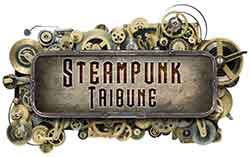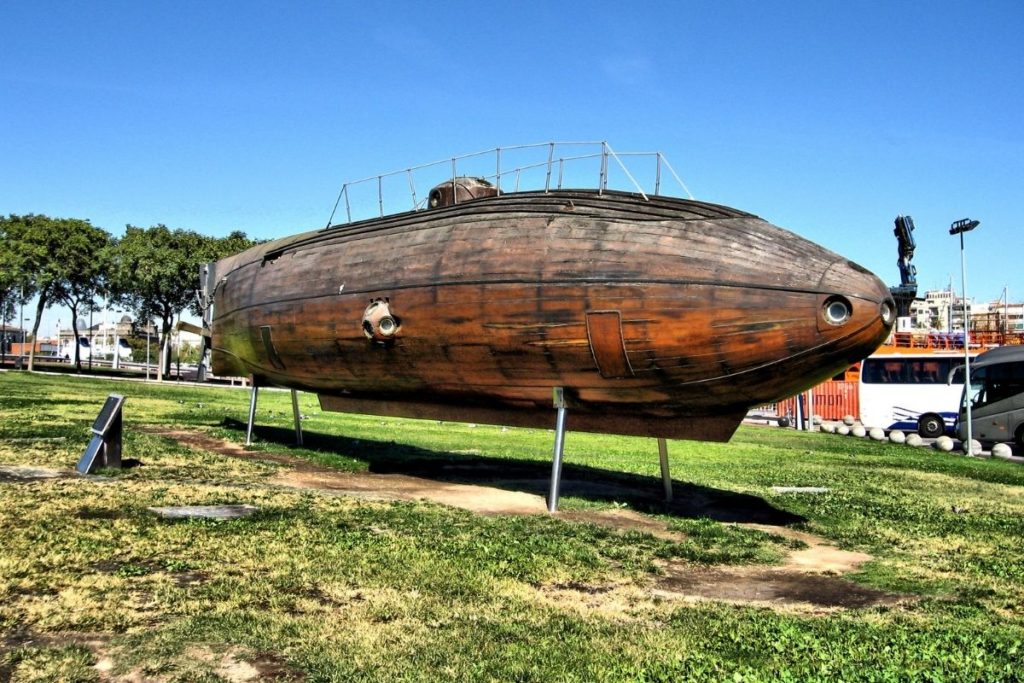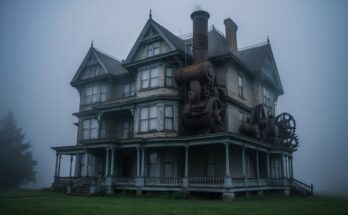The Steampunk Movement is a subculture that has gained popularity in recent years. It is a unique and fascinating blend of Victorian-era style and steam-powered technology. The movement has its roots in science fiction and fantasy literature, but has since expanded to include art, fashion, and even music.
Steampunk enthusiasts are drawn to the aesthetics of the Victorian era, with its ornate designs and attention to detail. They also appreciate the ingenuity of steam-powered technology, which they believe represents a time when people were more connected to the machines they used. The movement has inspired a wide range of creative expression, from elaborate costumes and accessories to intricate sculptures and paintings.
Overall, the emergence of the Steampunk Movement has brought a new level of creativity and innovation to the art world. Its unique blend of Victorian-era style and steam-powered technology has captured the imaginations of people around the world, and its influence can be seen in everything from fashion to film.
Historical Context
Victorian Era Influence
The Steampunk Movement is heavily influenced by the Victorian Era, which lasted from 1837 to 1901. During this time, the British Empire was at its peak, and the country was experiencing significant social and economic changes. The Victorian Era was characterized by a strict social hierarchy, with the upper class enjoying a luxurious lifestyle while the lower class struggled to make ends meet. This class divide is reflected in the Steampunk Movement, where characters are often divided into the wealthy elite and the working-class.
Industrial Revolution Impact
The Industrial Revolution, which began in the late 18th century and continued into the 19th century, also had a significant impact on the Steampunk Movement. The invention of steam-powered machinery revolutionized the way goods were produced, and factories began to spring up all over Britain. This period of rapid industrialization is reflected in the Steampunk Movement, where steam-powered machines and factories are a common theme.
Subgenre Origins
The Steampunk Movement started as a subgenre of science fiction and fantasy literature in the 1980s and has since expanded into a cultural movement that encompasses fashion, art, and music. The term “Steampunk” was first coined in the 1980s by author K.W. Jeter, who used it to describe his own work and the work of other authors who wrote stories set in a Victorian-era world where steam-powered technology was dominant.
The Wild West and local history also play a role in the Steampunk Movement. The American West was a significant part of the Victorian Era, and many Steampunk stories are set in a Wild West setting. Local history also influences the Steampunk Movement, with many cities holding Steampunk-themed events and festivals.
Overall, the Steampunk Movement is a unique blend of Victorian-era aesthetics and steam-powered technology, influenced by the Industrial Revolution and the Wild West. It is a cultural movement that continues to evolve and grow in popularity.
Key Figures in Steampunk
Literary Pioneers
Steampunk, as a literary genre, has its roots in the works of several authors who wrote during the late 19th and early 20th centuries. Jules Verne and H.G. Wells are often cited as the fathers of science fiction, and their works have had a profound influence on the steampunk movement. Verne’s “Twenty Thousand Leagues Under the Sea” and Wells’ “The Time Machine” are classics that helped to establish the genre’s fascination with technology and exploration.
William Gibson, K.W. Jeter, and Bruce Sterling are considered to be the pioneers of the modern steampunk movement. In 1990, they co-wrote “The Difference Engine,” a novel that explored an alternate history in which Charles Babbage’s mechanical computer had been successfully built in the 19th century. This book helped to popularize the steampunk aesthetic and set the stage for the movement’s growth.
Film Influencers
Steampunk has also been heavily influenced by cinema. The 2003 film “The League of Extraordinary Gentlemen,” based on the graphic novel by Alan Moore and Kevin O’Neill, was a major inspiration for many steampunk enthusiasts. The film’s depiction of a group of Victorian-era adventurers, including Allan Quatermain and Captain Nemo, helped to cement the genre’s focus on exploration and adventure.
Music Contributors
Music has also played a significant role in the development of the steampunk movement. Bands like Abney Park, The Clockwork Quartet, and The Cog is Dead have all helped to popularize the genre through their music. Many of these bands incorporate steampunk themes and aesthetics into their performances, creating a unique and immersive experience for their fans.
Other notable figures in the steampunk movement include Tim Powers, James Blaylock, and China Miéville. Powers’ “Morlock Night” and Blaylock’s “Homunculus” are early examples of steampunk literature, while Miéville’s “Perdido Street Station” is a more recent addition to the genre. Jeff Vandermeer and Mervyn Peake are also worth mentioning for their contributions to the genre.
Overall, the steampunk movement has been shaped by a diverse group of individuals, each bringing their own unique perspectives and talents to the table. Whether through literature, film, or music, these key figures have helped to create a vibrant and exciting subculture that continues to captivate audiences around the world.
Steampunk in Literature
Classic Works
Steampunk literature has its roots in classic works of science fiction and fantasy. One of the earliest examples of steampunk literature is H.G. Wells’ “The Time Machine,” published in 1895. The novel features a time traveler who journeys to the future and encounters a society divided into two classes: the Eloi and the Morlocks. The story’s Victorian-era setting and use of advanced technology make it a precursor to the steampunk genre.
Another classic work that has influenced the steampunk movement is the 1960s television series “Wild Wild West.” The show, which follows the adventures of two Secret Service agents in the Old West, features anachronistic technology and gadgets that would later become staples of the steampunk aesthetic.
Contemporary Masterpieces
In recent years, steampunk literature has gained popularity, with many contemporary masterpieces being produced. One such work is “The Anubis Gates” by Tim Powers, published in 1983. The novel tells the story of a time traveler who is transported to 19th century London and becomes embroiled in a plot involving Egyptian gods and time travel.
Other literary works that have contributed to the steampunk movement include the “Leviathan” series by Scott Westerfeld, which reimagines World War I with steampunk technology, and “The Difference Engine” by William Gibson and Bruce Sterling, which explores an alternate history where Charles Babbage’s Analytical Engine was successfully built in the 19th century.
Overall, steampunk literature draws on classic works of science fiction and fantasy, while also incorporating elements of Victorian-era technology and aesthetics. These works have inspired a vibrant and growing community of steampunk enthusiasts and creators.
Steampunk in Visual Media
Film and Television
Steampunk has been a popular theme in film and television, with many productions incorporating elements of the subculture into their design and storytelling. From technology to characters, steampunk has become an art form that has captivated audiences worldwide.
One of the most well-known examples of steampunk in visual media is the 1999 film “Wild Wild West,” starring Will Smith and Kevin Kline. The film takes place in the 1800s and features steam-powered technology and elaborate gadgets, all of which are central to the plot. Another popular example is the 2004 film “Hellboy,” which features a mix of steampunk and gothic elements in its design.
Steampunk has also made its way into television shows, with the BBC’s “Sherlock Holmes” series being a notable example. The show features intricate Victorian-era sets and costumes, as well as steam-powered gadgets and technology.
Art and Design
Steampunk has also become a popular theme in art and design, with many artists and designers incorporating the subculture’s aesthetic into their work. From fashion to architecture, steampunk has become a recognizable style that is both unique and visually appealing.
One example of steampunk in fashion is the work of designer Thomas Willeford, who creates intricate steampunk-inspired outfits and accessories. Another example is the steampunk-inspired architecture of the Steampunk Tree House, which features a mix of Victorian and industrial design elements.
Overall, steampunk has become a popular subculture that has influenced many aspects of visual media, from film and television to art and design. Its unique aesthetic and focus on technology and innovation have made it a beloved art form that continues to captivate audiences around the world.
Steampunk Aesthetic and Fashion
Steampunk fashion is a unique and captivating style that has emerged as a popular subculture in recent years. It is characterized by a fusion of Victorian-era fashion and industrial design, featuring elements such as brass, leather, and gears. This section will explore the various aspects of the steampunk aesthetic, including clothing and accessEmergence of the Steampunk Movement: A Brief History and Cultural ImpactEmergence of the Steampunk Movement: A Brief History and Cultural Impactories, gadgets, and decor.
Clothing and Accessories
Steampunk fashion is known for its elaborate and intricate clothing, often featuring corsets, top hats, and goggles. It is not uncommon for steampunk enthusiasts to create their own DIY craft outfits, as the style is highly customizable. Etsy is a popular platform for purchasing steampunk style jewelry and clothing, as well as other accessories such as leather gloves and boots.
One of the defining features of steampunk fashion is the emphasis on utilitarian objects, such as gears and clockwork mechanisms. These objects are often incorporated into clothing and accessories, such as pocket watches and cufflinks. Additionally, steampunk fashion often features a mix of masculine and feminine elements, such as lace and ruffles alongside leather and brass.
Gadgets and Decor
Steampunk fashion is not limited to clothing and accessories – it also extends to gadgets and decor. Many steampunk enthusiasts enjoy creating their own Victorian mechanical gadgets, such as steam-powered machines or clockwork robots. These gadgets often feature intricate design elements, such as exposed gears and brass accents.
In terms of decor, steampunk enthusiasts often incorporate industrial design elements into their homes and workspaces. This can include vintage typewriters, antique telephones, and other utilitarian objects. Additionally, steampunk decor often features a mix of vintage and modern design elements, such as Edison-style light bulbs and industrial-style furniture.
Overall, the steampunk aesthetic is a fascinating and unique subculture that continues to grow in popularity. Its fusion of Victorian-era fashion and industrial design has created a distinctive style that is highly customizable and endlessly fascinating.
Steampunk Subcultures
Steampunk has become more than just a fashion statement. It is a subculture that encompasses music, conventions, and cosplay. The following sub-sections will explore each of these aspects in more detail.
Music Scene
Steampunk music is a unique genre that blends Victorian-era aesthetics with modern-day instruments and technology. It is often described as a fusion of rock, folk, and industrial music. Steampunk bands have emerged all over the world, with notable artists including Abney Park, The Cog is Dead, and Steam Powered Giraffe.
The music scene has become an integral part of the steampunk subculture. Many steampunk conventions feature live performances from steampunk bands, and there are even entire festivals dedicated to steampunk music.
Conventions
Steampunk conventions are events that bring together enthusiasts of the subculture. They are often held in large cities and feature a variety of activities, including panel discussions, workshops, and vendor booths.
These conventions are a great way for people to connect with others who share their interests. They provide a space for people to express themselves through their fashion and creativity. Some of the most popular steampunk conventions include the Steampunk World’s Fair and DragonCon.
Cosplay
Cosplay is an important part of the steampunk subculture. It allows people to embody their favorite characters and express themselves through their fashion. Steampunk cosplay often involves elaborate costumes that incorporate Victorian-era clothing and accessories.
There are many talented steampunk cosplayers who have gained recognition for their work. Some even compete in cosplay contests at conventions and events.
Overall, the emergence of the steampunk subculture has been a fascinating development. It has become a vibrant and creative community that celebrates Victorian-era aesthetics and technology. With its unique culture, music, and fashion, steampunk is sure to continue to be the next big thing in the underground movement.
Steampunk in Technology
Modern Applications
Steampunk, a sub-genre of science fiction and fantasy, has been gaining popularity in recent years. The movement is characterized by its fusion of retro and futuristic elements, often featuring mechanical and steam-powered technology. In modern times, steampunk has found its way into various applications, from fashion to interior design, and even technology.
One example of steampunk technology is the iPhone case designed by John Dunn. The case is made from a combination of brass and wood, giving it a vintage feel. It also features a small brass crank that can be turned to charge the phone’s battery. This design is a perfect example of how steampunk can be incorporated into modern technology.
Another application of steampunk technology is the wheelchair designed by Greg Hurley. The wheelchair features a steampunk-inspired design, complete with gears and brass accents. The design not only looks unique but also improves the functionality of the wheelchair. The gears allow the user to adjust the seat height and tilt, making it more customizable and comfortable.
Futuristic Predictions
Steampunk’s fusion of retro and futuristic elements also makes it a popular choice for predicting the future of technology. While it may seem contradictory to mix old and new technology, steampunk enthusiasts believe that it is possible to create a future that combines the best of both worlds.
One example of this is the steampunk-inspired city of New Babbage. The city is a virtual world that imagines a future where steam-powered technology is still prevalent. The city features airships, steam-powered trains, and other steampunk-inspired technology. This vision of the future shows that steampunk can be used to create a unique and exciting world that combines the best of both old and new technology.
In conclusion, steampunk technology is an exciting and unique application of the steampunk movement. It combines retro and futuristic elements to create something that is both functional and aesthetically pleasing. With its growing popularity, we can expect to see more steampunk-inspired technology in the future.
Themes in Steampunk
Alternate Histories
One of the defining characteristics of steampunk is its use of alternate histories. This subgenre of speculative fiction often explores what the world would be like if certain events in history had unfolded differently. In steampunk, this typically means imagining a world where steam power and clockwork technology remained dominant, rather than being supplanted by electricity and digital technology.
Steampunk authors often take real historical events or figures and reimagine them in a steampunk context. For example, in William Gibson and Bruce Sterling’s The Difference Engine, Charles Babbage’s mechanical computer is successfully built, leading to a vastly different Victorian era. Similarly, Cherie Priest’s Boneshaker imagines a steampunk version of the American Civil War, where Confederate forces have developed a deadly gas weapon powered by clockwork.
Social Commentary
Another common theme in steampunk is social commentary. Because the genre often takes place in a dystopian or alternate version of the past, it can be used to comment on current social issues in a way that feels removed from the present day. Steampunk authors often explore themes of class, race, and gender, imagining how these issues might have played out differently in a world powered by steam.
For example, in China Miéville’s Perdido Street Station, the city of New Crobuzon is a melting pot of different species and cultures, but also plagued by corruption and inequality. The novel explores themes of xenophobia and oppression, imagining a world where fantastical creatures are marginalized and exploited by the ruling class.
Overall, steampunk is a rich and diverse subgenre of speculative fiction that offers a unique blend of fantasy, alternate history, and social commentary. Whether exploring the possibilities of clockwork technology or imagining a world where the past took a different path, steampunk authors continue to push the boundaries of what is possible in speculative fiction.
Steampunk’s Influence and Future
Global Impact
The Steampunk movement has had a significant impact on popular culture around the world. Steampunk has inspired a whole generation of artists, designers, and writers to create new works that draw on the aesthetics and themes of the movement. The Steampunk influence can be seen in a wide range of media, including films, television shows, video games, and literature.
Steampunk’s influence can be seen in the fashion industry as well. The movement’s aesthetic has inspired designers to create clothing lines that incorporate elements of Steampunk style, such as corsets, top hats, and goggles. In addition, Steampunk has also influenced the world of cosplay, with many fans dressing up as their favorite Steampunk characters at conventions and other events.
Emerging Trends
As the Steampunk movement continues to grow, new trends are emerging within the community. One of the most notable trends is the rise of individual artisans and makers who create unique Steampunk-inspired creations. These artisans often work with a variety of materials, including brass, copper, and leather, to create one-of-a-kind pieces that reflect the Steampunk aesthetic.
Another emerging trend within the Steampunk community is the use of airships as a plot device in literature and other media. The popularity of Jules Verne’s “Twenty Thousand Leagues Under the Sea” and William Gibson’s “The Difference Engine” has helped to popularize the use of airships in Steampunk stories. In addition, the use of airships in Steampunk has also led to an increased interest in engineering and the mechanics of flight.
Looking to the future, it is clear that Steampunk will continue to influence popular culture and inspire new works of art, literature, and design. With its unique blend of Victorian-era aesthetics and futuristic technology, Steampunk offers a rich source of inspiration for creatives around the world. Whether it’s through fashion, literature, or art, Steampunk is sure to remain a vibrant and exciting movement for years to come.




